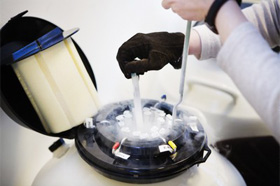Semen Banking

-
What is artificial insemination with Donor sample (AID) or Donor Insemination (DI)?
In as many as 30 % of infertile couples the male is responsible for infertility. A significant percentage of these males do not father children despite various treatments including ICSI. The solution is inseminating their wives with semen of another male (donor) at the time of her ovulation. This procedure is called AID or DI.
Who can benefit from AID?
1. AID (Artificial Insemination Donor ) is generally advocated for males with low semen counts (Oligospermia or zero counts) (Azoospermia), where treatment with drugs, surgery and ART treatments like AIH, IUI and ICSI have proven unsuccessful. It is an acceptable alternative to adoption.
2. It is also suggested to males who may have a genetic disorder that could get transmitted to their progeny.
3. It may be used as a backup to the procedure of TESE (Testicular Sperm Extraction) and ICSI that is done for males with non-obstructive Azoospermia, especially when no sperms are found in the testicular biopsy. (see Nonsurgical Sperm Retrieval)
How is the Semen obtained in Semen Banking?
A donor male donates the semen after he is screened and tested as safe for various infections such as HIV, Hepatitis and other Venereal Diseases. At BabiesandUs lab, we test the donor for infections every 3 months. The semen thus obtained can be used in two ways:
1. Fresh Semen Insemination:
It is insemination where the donated semen is used within an hour of ejaculation. The semen can be placed on the cervix without processing or can be placed in the womb after processing as is usually done with IUI. This is done commonly in India. However, there is always the remote chance of a donor carrying the latent infection of HIV that may manifest itself as a positive after 2 to 3 months of the insemination. It is due to these reasons many ART units have given up this technique.2. Frozen Semen From Semen Bank:
After collecting the semen from an HIV negative donor, it is processed, added to straws or vials. These are then stored in liquid nitrogen containers called semen banks, of -196ºC for six months. In short, it is quarantined. After 6 months the donor is retested for HIV. If the second HIV test is negative, this sample is released from quarantine and insemination takes place only at that time.Which of the two is a better alternative?
The success rate of both fresh as well as frozen AID is almost similar. However in case of frozen AID it is important to accurately pinpoint the timing of ovulation. This is because the motility of frozen thawed sample decreases rapidly within 12 hours, in contrast to fresh insemination, where the sperms stay alive in the body for 48-72 hours.However, the biggest advantage of frozen samples are its minimal risk of HIV transmission.
What is the Success rate of AID (Artificial Insemination Donor) ?
The success rate is in the region of 15-20%. That means if 10 couples undergo AID every month, 1 or 2 couples would become pregnant every month. At the end of 6 months 5 to 6 couples become pregnant. The remaining 4-5 couples who do not become pregnant, can undergo further AID for 6 months. During this time 2 more will become pregnant. At the end of one year around 80% (8 out of 10 started couples)will acheive pregnancy. The two couples who fail to become pregnant at the end of one year can either opt for IVF/ICSI with donor sperm or go in for adoption



 Book an Appointment
Book an Appointment